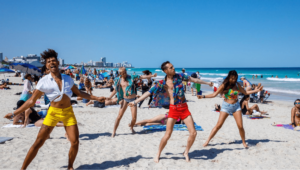As we slowly return to live events, it’s important to determine if your pre-pandemic, tried-and-true venues can still meet safety requirements for your area. Taking the time to do your own event risk assessment during every stage of event planning can help you choose a venue and mitigate risk before your tickets even go on sale. We’ve pulled together a list of factors to consider as you plan your next event so you can keep attendees safe and entertained.
The planning process
You know that planning ahead is crucial for any event, but this is especially true in the wake of the COVID-19 pandemic. Take into account social distancing guidelines to determine how many people a venue can comfortably hold, and cap your attending number accordingly. Consider surveying your attendees to find out how comfortable they are with in-person events, and use that information to help decide how you should format your event. If many ticket buyers are still nervous about attending in person, a hybrid event with a virtual component is a good option.
COVID-19 restrictions are not the same everywhere, so make sure you have the most up-to-date information on local regulations when you’re planning your event, and check in frequently with your sources so you’re aware of any changes. When in doubt, consult your local authorities.
Before the event
Once you’ve secured your venue and planned your event, take special care with your pre-event preparations. Reference CDC guidelines and check to make sure that your venue has appropriate ventilation. Find out if there’s an onsite cleaning staff and, if so, ensure that their cleaning and disinfecting practices meet CDC guidelines. It may also be helpful to know how soon before the event your space will be cleaned, and if you will need to assign staff or hire a cleaning service to disinfect surfaces after shifts or waves of attendees.
Inform attendees prior to the event day about the safety policies you have in place, and what the consequences are if they don’t follow those policies. Communicate what is required of attendees in order for the event to proceed safely for everyone, such as wearing facial masks and practicing social distancing from other attendees. If you’re not sure where to start, check out our email template for communicating your safety practices to guests.
Consider coming up with a floor plan that allows your attendees to move easily throughout the event space while still adhering to social distancing guidelines. Event creators at ServedUp, a live event series that seeks to connect people safely and mindfully, designed a strategic floor plan with appropriately distanced seating areas and enough space for attendees to safely flow through.
At the event
Keep things clean, efficient, and as touch-free as possible by clearly communicating expectations to attendees. Have signs posted throughout the event instructing attendees to wear proper face coverings and to practice social distancing. Consider posting signs in bathrooms and at hand-washing stations that instruct your attendees how to wash hands properly.
It’s important to manage the flow of attendees into your event space, so you might consider staggering arrival times to prevent crowding. If you plan to send health questionnaires or waivers to your attendees, you might want to send them ahead of time, like the creators of ServedUp. “We had worked through a custom health questionnaire that we sent out 24 hours ahead of the event through the Eventbrite site. If [attendees] didn’t fill it out before they got there, they were able to scan it and just do it right there on their phone.”
Current CDC guidelines state that even fully vaccinated persons should wear appropriate face coverings when in the presence of unvaccinated or potentially unvaccinated people. Have your staff wear masks to demonstrate to attendees how to properly wear face coverings. Clearly communicate with your attendees about non-negotiable attendance requirements ahead of your event to prevent confusion on issues.
Aside from wellness questionnaires, you may require more in-depth screening of attendees when they arrive at your event, such as administering COVID-19 temperature checks or requiring proof of vaccination. ServedUp worked with an event medic company in order to temperature check and properly screen individuals at their event entrances.
Weighing risk
Your COVID-19 event risk assessment is likely to demonstrate that there are going to be some risks at your event no matter what, but in-person events can still be carried out safely with the right precautions. Keep informed about local restrictions and regulations leading up to your event and even check back on the day of to make sure it is advisable to go forward with your plans. If your event is unable to move forward due to restrictions or other issues, consider taking your event online. In the event that cancellation or postponement of your gathering is the only option, use the opportunity to communicate these changes to your attendees gracefully and maintain their trust.
Using the Eventbrite organizer app for safe onsite check-in
Learn more about how you can use our app for easy contactless check-in and to track ticket sales so you stay on top of your headcount.
Ready to plan for a safe in-person event?
Putting on an enjoyable event while keeping attendees and staff safe isn’t impossible if you do an event risk assessment, and there are plenty of things to do while social distancing. For more information about event precautions as they pertain to COVID-19, check out our Safety Playbook for Events, which can help you get started on your event safety management plan template.






